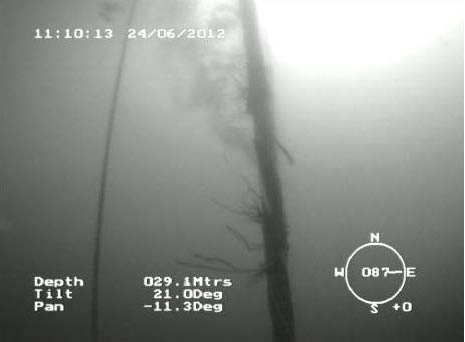- Discover how we are helping Members reduce emissions: Explore the ProjectGHG hub now.
- Join the global DP Community at the IMCA DP Conference in Amsterdam. 21 and 22 May. Book now
- Register your interest for the IMCA Global Summit 2024. 3-4 December, Utrecht, Netherlands.
- Now booking. Underwater Ship Husbandry Seminar. 10 October 2024, Singapore.
Near-miss: Bell umbilical damage incident
A member has reported an incident in which a diving bell umbilical was damaged after it was trapped between the cursor and the bell. After completion of diving operations a deck foreman was in the vessel bell garage assisting with bell recovery operations. He noticed that the white tape mark on the bell umbilical and the white tape mark on the cursor wire were not aligned as the curser started to rise. He called an ‘all stop’ and the situation was investigated.
It was found that the umbilical was snagged under the upper guide wire slot on the cursor and was trapped between the cursor and the bell. The deck foreman advised the dive supervisor who lowered the bell back to 30m of sea water, in order to investigate the problem further. The umbilical was freed by slackening it and slowly raising the bell on the main winch. A Remote Operated Vehicle (ROV) was used to check the condition of the bell umbilical.
A slight leak was detected from damage observed to the umbilical outer sheath and a small amount of gas could be seen coming from one of the small pneumo-fathometer hoses. The divers secured the pneumo valves and the leak was stopped. The bell left 30m and internal pressure was maintained. The bell arrived on surface and was locked onto the system. All of the bell internal valves were closed and the system was bled down and the bell prepared for surfacing and sealed. All valves were secured inside the bell and the bell was recovered with the correct amount of tension on the umbilical for immediate transfer of the divers and assessment of the damage in the dry. There was no loss of integrity to the bell and the divers inside were unharmed.

During an investigation the following points were noted:
- The immediate cause of the incident was found to be that the dive supervisor did not ensure sufficient tension on the bell umbilical to eliminate the risk of it bunching, trapping and being damaged during bell recovery operations;
- Underlying causes identified were as follows:
- loss of control: the dive supervisor lost concentration when distracted during the aft bell recovery operations/activities. Existing procedural and engineering control measures which might have prevented this were not effectively applied
- design: the differential read-out monitor alarm indicator is a visual alarm only, and not audible also, which could go unnoticed;
- It was unclear whether or not the dive supervisor had noticed the visual alarm (red flashing bell in the screen of the differential read-out monitor) which highlights the differential selected for each dive undertaken;
- The dive supervisor was a very experienced member of the dive team, with great experience in using on-board bell launch and recovery systems, and had performed bell deployment and recovery operations numerous times in the past. On this occasion the dive supervisor believes he had become distracted and had not paid attention to the length of umbilical paid out prior to recovery;
- Experience and competence in tasks does not mean that the risks of being distracted, or losing focus, does not remain high when undertaking what may be considered ‘routine’ tasks; The following corrective and preventative actions were taken:
- Re-termination of umbilical;
- Installation of an audible alarm onto the differential panel read-out on the hydraulic control panel, which will enhance pre-existing warning controls of differentials when recovering dive bells;
- Bell launch/recovery risk assessments reviewed and updated with incident findings and addition hazard control measures.
Safety Event
Published: 24 July 2012
Download: IMCA SF 08/12
IMCA Safety Flashes
Submit a Report
IMCA Safety Flashes summarise key safety matters and incidents, allowing lessons to be more easily learnt for the benefit of all. The effectiveness of the IMCA Safety Flash system depends on Members sharing information and so avoiding repeat incidents. Please consider adding [email protected] to your internal distribution list for safety alerts or manually submitting information on incidents you consider may be relevant. All information is anonymised or sanitised, as appropriate.
IMCA’s store terms and conditions (https://www.imca-int.com/legal-notices/terms/) apply to all downloads from IMCA’s website, including this document.
IMCA makes every effort to ensure the accuracy and reliability of the data contained in the documents it publishes, but IMCA shall not be liable for any guidance and/or recommendation and/or statement herein contained. The information contained in this document does not fulfil or replace any individual’s or Member's legal, regulatory or other duties or obligations in respect of their operations. Individuals and Members remain solely responsible for the safe, lawful and proper conduct of their operations.
